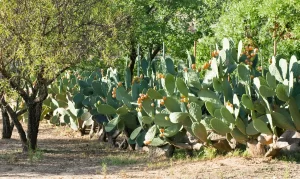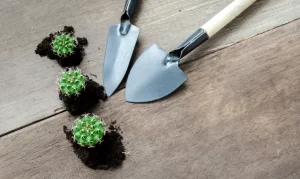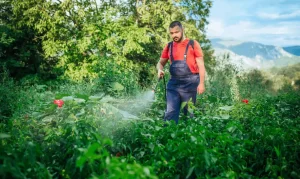How to Kill Prickly Pears: Detail Tips & Tricks: Any experienced gardener knows killing a cactus is not easy. But you have to ensure regular maintenance, especially when controlling invasive species, such as prickly pear cactus. Native to the southwestern United States, this species of cactus has a thorny problem.
Cactus grow in places where there is nothing else in drought conditions and quickly occupy the entire pasture. If you find a lot of prickly pear forests where tall grasses have grown, you have to take it seriously and ask an expert to know how to kill prickly pear cactus.
Contents
How to Kill Prickly Pears? Useful Methods
Generally, there are two recommended prickly pear control methods for removing: spraying or using a hoe (single plant) or a loader (large area). Sometimes burning is an option to control invasive cactus, but many other dry shrubs are needed in that case. According to the growth of the cactus and the surrounding vegetation, spraying and pulling or using herbicides have their advantages and disadvantages. Temperature and rainfall will also affect the success of these methods. Cost is also an essential factor.
Expert Tips: Cactus is not easy to burn, and the fire is not recommended to try on gardens. The burning ban imposed in most countries made this method unusable.
Remove with Hands
To get rid of prickly pear cactus, you can uproot them with hand use tools for a single one or small area. In this case, just cut the prickly pear and dig it out. Choose a windless day and avoid blowing loose thorns on your skin and clothes. Use sharp pruning shears, pruning shears, or a knife to remove the outer pad first and then remove the inner pad. Put the pad in a heavy-duty garbage bag for disposal. Reserve some mats for rooting in case you want to breed prickly pears.
After digging out the mat exposed at the base of the plant, dig it out. Discard it or plant it elsewhere. If you plan to eradicate the plants in the current location, dig out the roots because if some stems are left in the soil, the cactus may regrow. Remove the root balls or fruits left on the ground to prevent the cactus from growing again. In the next few years, check the cactus seedlings and remove them while still young because the seeds remain in the soil and germinate even after a few years.
Expert Tips: Wear protective clothing, such as heavy, closed work shoes, trousers, long-sleeved shirts, hats, gloves, etc, because the prickly pear has hairy thorns, which may hurt your uncovered body parts. Wear safety glasses to prevent the crochet from entering your eyes.
Top Removal Method of Prickly Pears
Skid steer loader to remove prickly pear is generally considered the most effective, fastest, and most environmentally friendly method to remove large areas of prickly pear forest. This process allows the operator to remove a few inches of roots, enough to kill the plant. Experts suggest digging a pit to bury the uprooted cactus in 18 to 24 inches of soil (unlike cedar, cedar can be stacked and burned, and the stacked cactus will re-root and form an insurmountable soil.).
Learn about Is It Safe to Grow Vegetables in Plastic Containers?
At the same time, pick up as many dropped pads as possible. Any pads left on the ground may take root and form new cacti. Although mechanical weeding can be carried out all year round, autumn and early winter are the most suitable and can be replanted in time during the growing season.
Expert Tips: Use a skid steer loader equipped with a stone rake to handle extensive prickly pear forests. The teeth of the stone rake allow the gravel to fall back to the ground, plummeting topsoil loss and handling weight.
-
Using Herbicides
If you are interested in permanently removing prickly pear cactus from the yard, herbicides are also an option. High-strength herbicides control prickly pear, but opportunities for home gardeners are limited. Herbicides that treat prickly pear infestations also kill grass and desirable plants, leach into groundwater, and remain in the soil. After herbicide spraying, prickly pear plants take six to eight months to become effective and two to three years before their infestations are finally controlled.
Notes: Treating prickly pears with herbicides is a job for professional contractors licensed to apply the required herbicides and are trained in their safe use.
-
Limit the Spread
Limiting the spread is also an option when you search for how to kill prickly pear cactus. Good garden hygiene prevents prickly pear from spreading. Prickly pears spread to other garden parts when their pads and seeds become lodged on clothing and garden tools. Examine your clothing and garden tools after removing prickly pears, and use leather gloves to remove all seeds and other plant debris. Dispose of them in a thick plastic bag and throw the bag in the trash. Clothes and tools must be washed thoroughly. Do not mow areas infested with prickly pear, which will spread the plants.
-
Follow-Up
Successful prickly pear control includes follow-up of a previously infected area. Apply water regularly to keep the site soil moist. It is essential to check weekly for new plants and pull out any that emerge. Wear protective clothing when removing the new plants. An alternative aftercare method covers the area with weed-suppressing landscape fabric and organic or inorganic mulch such as gravel or pebbles.
Expert Tips: Since prickly pears thrive in hot, dry conditions, reduce the likelihood of the plants regrowing in the area by watering the area thoroughly and spreading a 3-inch-thick layer of organic mulch such as well-rotted manure or garden compost.
Final Thought: How to Kill Prickly Pears?
If you want to know how to kill prickly pear cactus completely, successfully, and forever, remove them from roots below the soil surface to kill them permanently. Wearing a long-sleeved shirt, long pants, leather gloves, and safety glasses or goggles before approaching prickly pear cacti will protect you from the plants’ sharp spines and bristles while you work with the cacti. On a hot, dry day, push a hoe or sharp spade into the soil until it is 2 to 4 inches below the soil surface and use the tool to cut through all prickly pear roots.
Notes: Remove all parts of the cactus from the area. Prickly pear cactus parts left on the ground may become new plants.




